Abby Baggini ’18: In the 2015-16 school year, the Upper School Math Department will switch the order in which students will take their Math courses. “The Math Department has been discussing and analyzing pros and cons of the order switch for three years. This year, we especially focused department meetings and in-service days towards summarizing our discussions and working through the logistics,” stated department head Grace Wingfield.
For more than 20 years, Algebra 2 has been taken freshman year upon completing Algebra 1 in middle school. Geometry has been taken in sophomore year, followed by Pre-Calculus junior year. Starting next year, freshmen will take Geometry before Algebra 2. Math teacher Tanuja Murray explained that the department’s hopes were to provide better opportunities and direction for honors placement for sophomores and freshmen, align Math courses more appropriately to the science courses, and create a smoother transition into Pre-Calculus.

Photo Courtesy of Sammi Ciardi
“Geometry uses a different type of thinking,” commented Murray, “but it has a lot of leeway, so we can still find time to thread the basic Algebra 1 concepts into it.” Having had a year of Geometry as freshmen will allow students to get a feel for the way that Upper School Math works, and give them a better understanding of where their placement would be for the following years. It could also potentially help the Math students who would otherwise have to take a bridge course to transition from regular Algebra 2 into Honors Geometry. In addition, the Math curriculum will now be better aligned with the science courses. Chemistry, which is Math heavy, will be taken the same time as Algebra 2. This way, the concepts being learned in Math will be more easily applied in Chemistry, allowing the science teachers to spend less time reviewing basic algebraic concepts.
By changing the subject order, incoming students, who would have taken Geometry followed by Algebra 2, will find the transition much better. Additionally, sophomores who take the PSAT will have already been taught the largely geometry-based Math section. Although the curriculum change wasn’t specifically structured around these things, it is “an unintended benefit,” as Dinkins called it.
The current eighth and ninth grade class will both be taking Geometry next year, which in turn will require more Geometry based teachers. Murray and Chung, who do not normally teach Geometry, will each be temporarily taking on an extra section as the transition occurs. This alteration however, will not impact the way that future freshmen will qualify for Honors Geometry. Middle School Math Chair Allison Schultz clarified, “Our students will still have to maintain an A average and earn an A on the final exam.”
Since 2015-16 will be the transition year, the current eighth graders will be the “guinea pigs” as the first class to undergo this change. The feedback from the class of 2019 is generally positive. However, Jack Franklin ’19 disagrees stating that, “I think two years of algebra-based classes is a good thing. It makes sense to do them within a two year period so you can easily build off of what you learned the past year without having to review as much.” Fellow classmate Annie Rau ’19 is more interested in the way that the transition year will play out. “I think it will be weird to be in the same classes as the ninth graders since they have already had another year’s worth of experience in Math,” she said.
The figures behind the decision are excited to see how the change will unfold. “We will now need to track progress of students and hopefully see a positive impact on both Algebra 2 and Pre-Calculus,” said Wingfield. Dinkins finished by stating, “I think it’s going to have a positive impact. I’m really curious to see what teachers say about how kids are learning, whether they can learn in depth or at a faster pace, and whether those who are more reluctant about Math begin to have a better experience.”